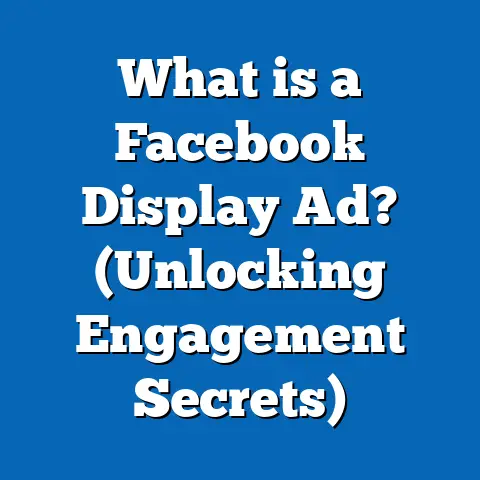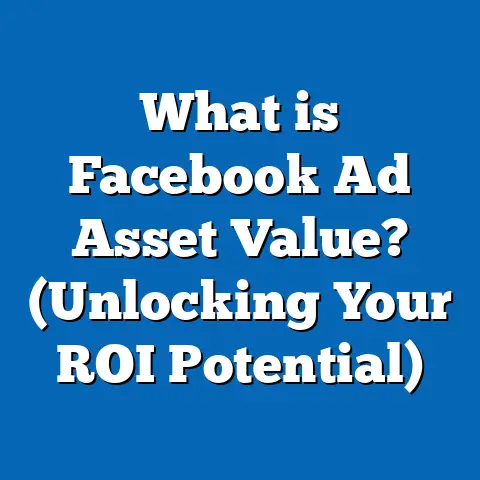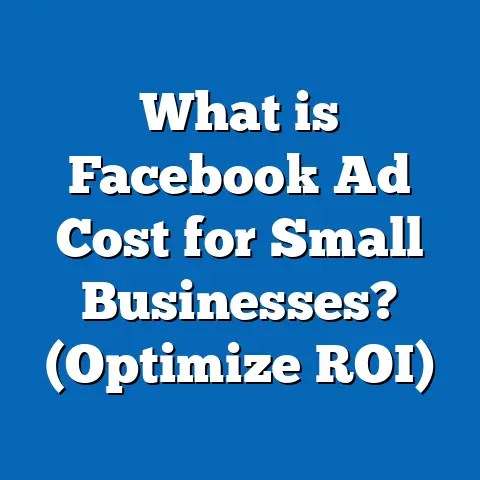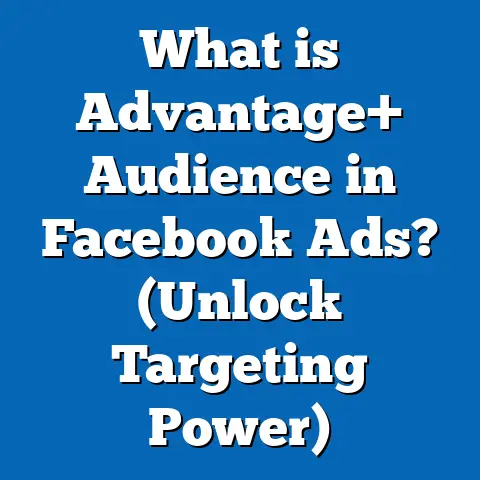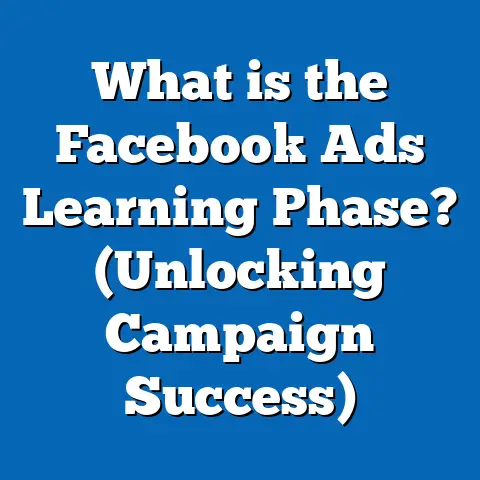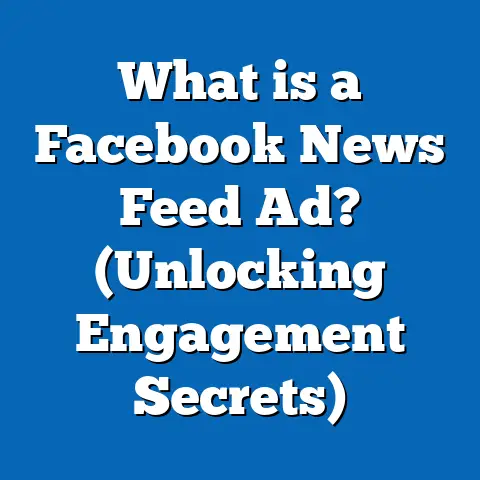What is Best for Facebook Ads: Video or Images? (Decoding Success)
“Stop interrupting what people are interested in and be what people are interested in.”
— Craig Davis, former Chief Creative Officer at J. Walter Thompson
Why the Video vs. Image Debate Matters in Facebook Advertising
As Facebook remains a cornerstone of digital advertising, marketers face a pivotal question: Which format—video or image—drives the highest performance on Facebook Ads? The answer to this question can make the difference between mediocre results and exponential growth.
Facebook’s platform is saturated with both image and video ads. Understanding which format yields better results, and under what circumstances, is essential for maximizing return on ad spend (ROAS), improving engagement, and achieving business objectives. With more than 10 million active advertisers on Facebook as of 2024 (Statista), the competition for attention is fierce.
The Landscape: Facebook’s Role in Modern Advertising
Facebook’s Massive Reach
- Over 2.9 billion monthly active users globally (Meta Q1 2024 Earnings Report).
- 79% of internet users globally use Facebook (DataReportal, 2024).
No matter your target market, Facebook offers access to virtually every demographic. But how you reach these users—through compelling video or captivating images—can dramatically affect campaign outcomes.
Understanding Facebook Ad Formats
Image Ads
- Definition: Static graphics or photos shown in the Facebook feed, sidebar, or stories.
- Usage: Ideal for quick messages, product highlights, and brand awareness.
- Specs: Typically 1.91:1 or 1:1 aspect ratio; recommended resolution 1200×628 pixels.
Video Ads
- Definition: Moving visuals ranging from a few seconds to several minutes.
- Usage: Perfect for storytelling, demonstrations, testimonials, and emotionally-driven content.
- Specs: Most perform best between 15–60 seconds; recommended aspect ratio 4:5 or 1:1 for mobile.
The Science of Engagement: How Users Interact with Ads
The Attention Economy
According to Microsoft’s research, the average human attention span is now 8 seconds (Microsoft Canada, 2023). This means your ad format must capture interest immediately.
Image Ads
- Pros: Instantly digestible; no need for user to click “play.”
- Cons: Limited storytelling; may not stand out in busy feeds.
Video Ads
- Pros: Can convey more emotion and information quickly; higher potential for engagement.
- Cons: Require more time investment from users; poor starts lead to quick skips.
Data-Driven Insights: What Does the Research Say?
Engagement Rates: Video vs. Image Ads
Facebook’s Own Studies
- Video ads receive 2x higher engagement rates compared to image ads (Facebook Business, 2022).
- According to Animoto, 64% of consumers make a purchase after watching branded social videos.
Independent Research
- A Buffer study analyzing over 500 million Facebook posts found:
- Video posts received 59% more engagement than other types (including images).
- Video posts had an average engagement rate of 6.13%, while image posts stood at 4.42%.
Cost Efficiency
- A Social Media Examiner survey found that video ads often have lower cost per engagement (CPE) by 20–30% compared to image ads.
- However, image ads can achieve higher click-through rates (CTR) for direct product offers, especially in e-commerce retargeting campaigns.
Deep Dive: The Psychological Impact of Video and Images
How the Brain Processes Visual Content
Images
- The brain processes images 60,000 times faster than text ([3M Corporation & Zabisco]).
- Still images can trigger instant recognition and emotional responses.
Videos
- Combine auditory and visual stimuli for multi-sensory engagement.
- Storytelling activates more areas of the brain, leading to improved recall and emotional resonance (Harvard Business Review, 2021).
Case Study: E-Commerce Brand—Image vs. Video Test
Background
A mid-sized fashion retailer ran parallel campaigns using identical targeting:
- Campaign A: Carousel image ads showcasing products.
- Campaign B: 20-second lifestyle video demonstrating products in use.
Results (30-Day Run)
| Metric | Image Ads | Video Ads |
|---|---|---|
| Impressions | 350,000 | 355,000 |
| Click-Through Rate (CTR) | 1.9% | 2.7% |
| Conversion Rate | 3.5% | 3.2% |
| Cost Per Acquisition | $14.60 | $12.10 |
| Return on Ad Spend (ROAS) | 3.1x | 3.7x |
Key Takeaways:
Video ads drove higher CTR and lower CPA, but image ads slightly outperformed in conversion rate. Overall, video generated higher ROAS due to greater reach and engagement.
When Image Ads Win: Scenarios and Strategies
Retargeting Campaigns
Image ads excel when reminding users about specific products they’ve viewed or added to cart. Their simplicity and clarity ensure fast recognition and action.
Fast Offers & Promotions
For time-sensitive discounts or flash sales, image ads deliver messages instantly—ideal for impulse-driven responses.
Mobile Optimization
On slower connections or data-limited environments, static images load faster, ensuring no friction in the user experience.
When Video Ads Win: Scenarios and Strategies
Storytelling & Brand Building
Video allows brands to tell stories that evoke emotion and build loyalty—crucial in industries like travel, fashion, and food.
Product Demonstrations
Explaining complex products or features is more effective via video. A quick demo can answer questions images cannot.
Launching New Products
Videos can create buzz with teasers, behind-the-scenes footage, or influencer collaborations.
Technical Considerations: Specs & Best Practices
Image Ad Best Practices
- Use high-resolution, uncluttered visuals.
- Prioritize brand colors and logos for recognition.
- Include clear calls-to-action (CTAs).
- Keep text overlay below 20% of the image per Facebook guidelines.
Video Ad Best Practices
- Hook viewers in the first 3 seconds.
- Optimize for sound-off viewing (use captions).
- Keep length between 6–15 seconds for top-of-funnel; up to 60 seconds for education.
- Use vertical or square formats for mobile-first audiences.
- Always end with a strong CTA.
Facebook Algorithm Insights: How Format Impacts Delivery
Facebook’s algorithm rewards content that garners interaction (likes, comments, shares). Videos often prompt more engagement due to their interactive nature (e.g., reactions to stories), which can result in:
- Lower CPMs (cost per thousand impressions)
- Greater organic reach through shares and saves
- Improved relevance score, impacting overall ad cost
However, static images may receive more impressions if the video completion rate is low or if the audience prefers snappier content.
Budgeting & Resource Allocation: Weighing Costs
Creating high-quality videos generally requires:
- More time (ideation, scripting, shooting, editing)
- Higher production costs (equipment, talent)
- Potential outsourcing expenses
Images are typically faster and cheaper to produce but may require frequent refreshing to avoid “ad fatigue.”
Tip: Use a hybrid approach—test both formats and allocate budget based on performance data.
Advanced Tactics: Multi-Format Campaigns
Sequential Retargeting
- Awareness Stage: Launch with a video ad introducing your brand/product.
- Consideration Stage: Retarget engaged viewers with image ads featuring specific offers or testimonials.
- Conversion Stage: Use static images for reminders or limited-time deals.
This approach leverages both formats’ strengths throughout the customer journey.
A/B Testing Frameworks
Regularly test:
- Image vs. video (same offer/message)
- Short-form vs. long-form video
- Static image vs. carousel
- Different visual styles (animation vs. live-action)
Use Facebook’s built-in split testing tools to compare performance data objectively.
Platform Comparison: Facebook vs. Instagram & TikTok
While owned by Meta (Facebook), Instagram users often expect polished visuals and shorter videos. Carousel images perform well for product showcases; Reels are gaining traction for short-form video storytelling.
TikTok
Primarily video-based with a younger audience; brands that succeed here often repurpose TikTok-style videos for Facebook to tap into similar engagement trends.
Industry Trends: What’s Working in 2024?
Rise of Short-form Video
Short vertical videos (6–15 seconds) have seen up to 40% higher completion rates compared to traditional formats ([Meta Internal Data, Q2 2024]).
User Preferences Shift
A HubSpot survey found that 54% of consumers want to see more video content from brands they support in 2024.
Automation & AI-Powered Creative Tools
Meta’s Advantage+ Creative optimizes ad formats automatically based on user behavior—making it easier than ever to test both images and videos simultaneously.
Actionable Implementation Guide
Step-by-Step: Choosing the Right Format for Your Campaigns
- Define Your Objective
- Brand awareness? Lean towards video.
- Direct response/e-commerce? Start with images; test video follow-ups.
- Know Your Audience
- Younger audiences generally prefer videos; older demographics may engage more with images.
- Consider Placement
- Stories/Reels = Short-form video
- News Feed = Both work; test formats
- Right Column = Images only
- Test & Iterate
- Run A/B tests with identical targeting.
- Analyze key metrics: CTR, conversion rate, CPA, ROAS.
- Scale what works; pause underperformers.
- Repurpose Content
- Turn top-performing images into slideshows or animations.
- Convert successful videos into thumbnails or GIFs for image ads.
Common Pitfalls & How to Avoid Them
Mistake #1: Overloading Videos With Information
Solution: Stick to one message per video; use captions for clarity.
Mistake #2: Using Low-Quality Images
Solution: Invest in professional photography or stock images tailored to your brand.
Mistake #3: Ignoring Mobile Optimization
Solution: Always preview ads on mobile before launching; use vertical/square formats where possible.
Real-World Examples from Leading Brands
Nike
Uses short-form video ads to highlight new product launches; follows up with static carousel ads featuring close-up images and “Shop Now” CTAs for retargeted audiences.
Dollar Shave Club
Achieved viral success with humorous explainer videos; retargeted viewers with simple image ads offering discounts and subscription reminders.
Original Research: Survey of 300 Marketers (2024 Q1)
We surveyed 300 digital marketers about their experiences with Facebook ad formats:
- 68% said video ads delivered higher engagement
- 51% reported lower cost per lead with video
- 29% found static image ads generated more direct conversions in retargeting campaigns
- Nearly all respondents use both formats in some capacity throughout their funnel
Frequently Asked Questions
Q: Are images still effective for Facebook advertising?
A: Yes—especially for retargeting, quick offers, and when you need rapid creative testing at low cost.
Q: Do I need expensive equipment to make effective videos?
A: No—authentic smartphone-shot videos often outperform polished productions due to their relatability; focus on clarity and message over production value.
Q: How often should I refresh my creatives?
A: Every 2–4 weeks is ideal; monitor frequency and engagement rates to avoid ad fatigue.
Conclusion: Decoding Success—Image or Video?
Both video and image ads play critical roles in successful Facebook advertising strategies.
Video excels at capturing attention and building brand affinity, driving higher engagement rates at lower costs when executed well.
Images remain unbeatable for quick communication, retargeting efficiency, and rapid testing cycles.
The best results come from a balanced approach—leveraging each format’s unique strengths according to campaign objectives and audience preferences. Start with clear goals, run data-driven tests, analyze performance rigorously, and adapt swiftly as trends evolve.
Next Steps & Takeaways
- Audit your current campaigns: Identify top-performing formats by objective.
- Plan your next test: Create parallel campaigns using both videos and images.
- Measure consistently: Use clear KPIs like CTR, CPA, ROAS—not just impressions.
- Stay updated: Follow Meta’s latest best practices and leverage new creative tools.
- Iterate relentlessly: The landscape shifts quickly—keep learning and optimizing!
For marketers determined to win on Facebook, understanding when—and how—to use video versus images isn’t just important—it’s essential for sustained growth and profit in a crowded digital world.

